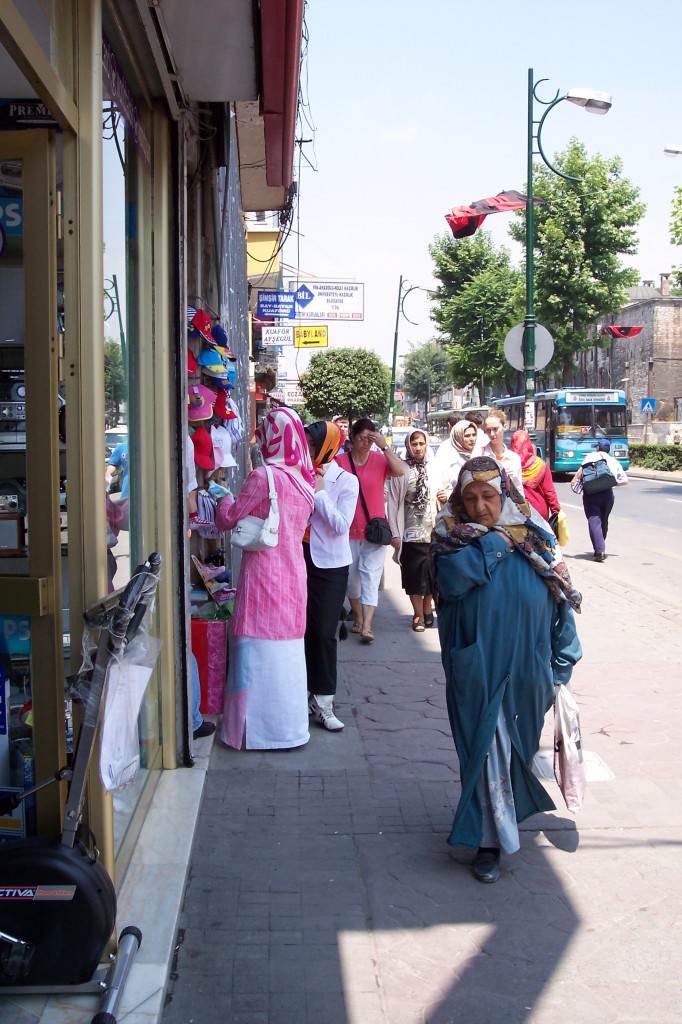Veiling in Turkey
 Following the establishment of the Republic of Turkey in 1923, the state implemented a series of extensive modernization and secularization programs. Although veiling was not banned, this practice was strongly discouraged at this time. The new republic depicted the veil as backwards and something of the past. While some women mostly in urban areas adopted the new dress styles, other women continued to cover their hair with headscarves.
Following the establishment of the Republic of Turkey in 1923, the state implemented a series of extensive modernization and secularization programs. Although veiling was not banned, this practice was strongly discouraged at this time. The new republic depicted the veil as backwards and something of the past. While some women mostly in urban areas adopted the new dress styles, other women continued to cover their hair with headscarves.
First attempts at officially regulating the headscarf were in 1970s when some civil servants and lawyers were asked not to cover their hair. In 1982, the newly established Council of Higher Education introduced a dress code that required “modern” dress at universities. This dress code targeted mainly the headscarf in its implementation, and therefore it is commonly referred to as the headscarf ban. The implementation of this ban varied from one university to another and from one time period to another. The headscarf that was subjected to this ban was a newly emergent style that was different from the traditionally worn headscarf. It was larger than usual, fixed with pins, and covered the hairline and the neck completely. This style later became the focus of a growing and diversifying fashion industry.
The headscarf ban started to be applied in other institutional spaces in the late 1980s and 1990s and this “pinned” style of headscarf was prohibited in military spaces, the parliament, and the courtroom. In the 1990s, as public debates turned the headscarf into a prime political issue, some headscarf wearing women faced discrimination in many other spaces. For example, some were refused service in public hospitals.
The Islamically-oriented Adalet and Kalkınma Partisi (AKP, Justice and Development Party) came to power in 2002 and attempted to make a constitutional amendment that would make it illegal for anyone to be excluded from the classroom in 2008. This amendment was overturned by the Constitutional Court leaving the dress code effectively in place. However, the ban is no longer applied on most university campuses due to political changes in university administrations and the Council of Higher Education. As of the fall of 2012, AKP is working on a legislation that would ban only certain kinds of veiling (such as the all-enveloping çarşaf and the face veil) of public employees and elected officials. This change would allow the headscarf.
A 2012 news article about women protesting legislation prohibiting headscarf-wearing women from running for public office and working in state offices (Today’s Zaman, October 12, 2012)
A learning guide about the politics of the headscarf and how it is covered by different news sources prepared by GLOWE for Grades 9-12 (Global Pulse, June 12, 2008)
Özdalga, Elisabeth.1998. The Veiling Issue, Official Secularism and Popular Islam in Modern Turkey. Richmond, England: Curzon.
Secor, Anna. 2005. Islamism, Democracy and the Political Production of the Headscarf Issue in Turkey. In Geographies of Muslim Women: Gender, Religion and Space, eds Ghazi Falah and Caroline Nagel. New York: Guilford Press, 203–25.
Leave a Reply
You must be logged in to post a comment.
